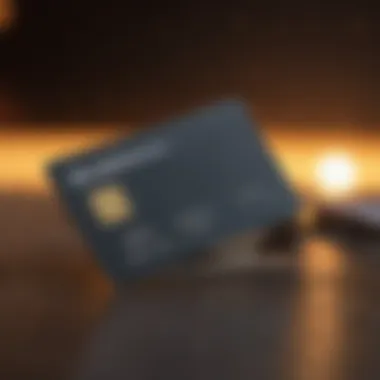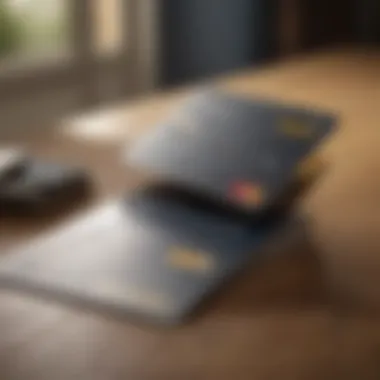Navigating Credit Card Options During Chapter 13 Bankruptcy


Intro
Navigating financial stability during Chapter 13 bankruptcy can be particularly challenging. For individuals seeking to maintain some level of credit access, understanding the complexity of credit card options is essential. This guide will delve into the implications of credit card use during bankruptcy proceedings while also providing actionable insights for responsible credit management under such conditions.
People often find themselves in financial hardship and looking for ways to rebuild their credit. It is crucial to comprehend how acquiring credit during this period may impact their bankruptcy case and their long-term financial future. This article aims to clarify the intersection of credit management and bankruptcy law, aiding the reader in making informed decisions.
Understanding Credit Cards
Types of Credit Cards
Credit cards come in a variety of forms, each with different features suited for various spending habits and goals. Common types include:
- Cashback cards: These allow users to earn a percentage of their spending back as cash. It is a practical option for those who often pay off their balance in full each month.
- Rewards cards: Users earn points for purchases that can be redeemed for travel or merchandise.
- Secured cards: Typically, these require a cash deposit but can be an effective tool for rebuilding credit after bankruptcy.
Credit Card Eligibility Criteria
Acquiring a credit card during Chapter 13 bankruptcy is not straightforward. Financial institutions generally consider factors including:
- Credit score: Many lenders will look for a certain credit score before approving a credit card application.
- Payment history: Your history of making timely payments can influence approval chances.
- Full disclosure: Being upfront about your bankruptcy status may play a role in lender decisions.
Credit Card Utilization Tips
After obtaining a credit card, managing it wisely becomes imperative. Here are strategies to help:
- Keep balances low: Aim to use less than 30% of your credit limit. This proactive measure helps maintain a favorable credit utilization ratio.
- Pay on time: Setting up automatic payments can prevent late fees and negative impacts on your credit score.
- Monitor your credit score: Tools like Credit Karma or services offered by banks can help track your progress.
Avoiding Common Credit Card Pitfalls
Even with the best intentions, it is easy to fall into credit card traps. Avoid these issues:
- Ignoring statements: Always review your bill for inaccuracies or unauthorized charges.
- Making only minimum payments: This can lead to high interest accumulating on your balance.
- Applying for multiple cards at once. This can trigger a hard inquiry on your credit report, which may reduce your score temporarily.
"Careful credit management can pave the path to financial recovery, especially during challenging times like bankruptcy."
It is beneficial for individuals under Chapter 13 bankruptcy to be discerning about their credit card choices. Knowing the types available, eligibility requirements, and effective management techniques can significantly affect one's financial situation and long-term credit standing.
Understanding Chapter Bankruptcy
Understanding Chapter 13 bankruptcy is essential for anyone considering their options for managing debt while under financial distress. This section aims to elucidate the core aspects of Chapter 13, providing a foundation for making informed decisions regarding credit card options during this period. Chapter 13 allows individuals to reorganize their debt, offering a structured approach to regain financial stability. This process can significantly impact one's overall credit standing, making it vital to grasp the specifics of Chapter 13 to navigate credit effectively.
Definition and Purpose of Chapter
Chapter 13 bankruptcy is a legal process that allows individuals with regular income to develop a plan to repay all or part of their debts. The main purpose is to provide debtors a way to retain their assets while addressing their financial obligations over a specified period, usually three to five years. Unlike Chapter 7 bankruptcy, which involves liquidating assets to pay creditors, Chapter 13 focuses on repayment. This framework helps individuals avoid foreclosure on their homes or repossession of their vehicles, offering a method to repay debts in a manageable way.
Key Features of Chapter
Chapter 13 bankruptcy comes with several distinctive features:
- Repayment Plan: This involves creating a repayment strategy based on income, debts, and necessary living expenses, which necessary creditors must accept.
- Automatic Stay: Filing for Chapter 13 triggers an automatic stay against creditors, temporarily halting collection actions and providing a much-needed breather.
- Debt Limits: Chapter 13 is limited to individuals with secured and unsecured debts below specific thresholds, ensuring it serves those who genuinely require assistance.
- Trustee Oversight: A court-appointed trustee manages the repayment plan, ensuring creditors receive payments as agreed upon. These features play a significant role in protecting the individual’s assets and allowing them to regain control over their financial future.


How Chapter Differs from Other Bankruptcy Types
Comparing Chapter 13 with other types of bankruptcy is crucial for understanding its unique role:
- Chapter 7 vs. Chapter 13: Chapter 7 involves immediate liquidation of non-exempt assets, while Chapter 13 allows individuals to keep their property and repay debts over time.
- Chapter 11 vs. Chapter 13: Chapter 11 is primarily for businesses, offering a more complex restructuring process, whereas Chapter 13 is designed for individuals with regular income.
- Duration: Chapter 13 repayment plans last three to five years, while Chapter 7 usually concludes in a matter of months. Understanding these differences is vital for anyone considering which bankruptcy option aligns best with their financial situation.
Can You Obtain a Credit Card During Chapter ?
Understanding whether it is possible to obtain a credit card while under Chapter 13 bankruptcy is essential for individuals facing financial hardship. Many may wonder if they have any access to credit after entering this form of bankruptcy. This question is significant as it affects the financial planning and stability of individuals trying to rebuild their lives. Access to credit can be crucial for emergencies, building credit scores, and managing everyday expenses.
While technically possible, the path to obtaining credit is layered with specific criteria and challenges. Knowing these criteria can help individuals prepare better. Moreover, fostering insight into the potential benefits of acquiring credit during this period is vital. Such benefits include the potential to build or rebuild one's credit score, which can be fundamental after bankruptcy.
Nonetheless, this journey is not without risks. Accumulating new debt may conflict with the repayment plan under Chapter 13. This situation creates a fine balance between using credit responsibly and adhering to bankruptcy guidelines. Engaging with this process mindfully will guide individuals through the complexities that lie ahead.
Eligibility Criteria for Credit Card Applications
When individuals consider applying for a credit card during Chapter 13 bankruptcy, several eligibility criteria must be met. First and foremost, it is essential to have all bankruptcy proceedings open and transparent. The court must approve any new credit incurred, which is a key step in the process.
Important factors influencing eligibility include:
- Credit Score: Although individuals may have a low credit score post-bankruptcy, some creditors still consider the application.
- Income Stability: A steady income that can support additional credit obligations is often looked at favorably by lenders.
- Existing Debt Obligations: This includes prior debts and the influence they have on managing new credit.
- Bankruptcy Plan Compliance: Remaining in compliance with the repayment plan established in bankruptcy proceedings is vital.
Overall, it is crucial for applicants to provide thorough and accurate information during the application process. Misinformation can lead to legal complications, further complicating one's financial recovery.
Challenges in the Application Process
Navigating the application process for a credit card during Chapter 13 bankruptcy presents distinct challenges. One of the most significant hurdles is the skepticism from lenders. Many financial institutions view individuals in bankruptcy as high-risk borrowers. This skepticism often leads to inflated interest rates or even outright denials.
Additionally, the borrower must contend with the following challenges:
- Increased Scrutiny by Lenders: Applicants are often subject to more stringent scrutiny given their bankruptcy status.
- Limited Options: There are fewer credit card options available for individuals with recent bankruptcy filings, making it challenging to find suitable offerings.
- Complicated Terms and Conditions: Credit card agreements may contain terms that are less favorable, including high-interest rates and fees.
Collectively, these factors indicate that while it is possible to obtain credit during Chapter 13 bankruptcy, one must carefully assess the risks and weigh them against the potential benefits.
"Be mindful of the credit you accumulate during bankruptcy; improper use can lead to more complications."
Taking a calculated approach is essential for anyone looking to navigate these complex waters.
The Impact of Credit Cards on Bankruptcy Proceedings
Understanding the impact of credit cards during Chapter 13 bankruptcy is crucial for anyone ho is navigating difficult financial circumstances. This section examines how obtaining credit can influence bankruptcy outcomes, identifying both potential advantages and significant risks. Individuals in Chapter 13 must approach the use of credit with caution. Any decision made affects not just their current financial state, but also their long-term credit health.
Strategic Use of Credit in Chapter
Using credit wisely during Chapter 13 bankruptcy can play a vital role in rebuilding creditworthiness. A common strategy involves acquiring a secured credit card. These cards require a cash deposit that typically acts as the credit limit. This practice can help individuals manage their finances better while repaying debts under the bankruptcy plan.
Considerations for using credit strategically include:
- Understanding limits: Knowing how much credit is available helps avoid overspending.
- Prioritizing essentials: Focus on using credit for necessary expenses like housing or transportation rather than indulgent items.
- Monitoring credit utilization: Keeping utilization ratios low on any available credit is essential for maintaining a favorable credit score.
This strategic application may foster a sense of stability and open doors for future credit opportunities post-bankruptcy.
Risks Involved in Accumulating Debt


Accumulating debt during Chapter 13 can easily derail repayment plans. Each new charge adds complexity to the financial landscape already under stress. Individuals may mistake the availability of credit as a sign that their financial issues have resolved, which can lead to impulsive decisions.
The risks of excessive debt can include:
- Increased financial strain: New obligations can make it challenging to meet existing repayment plans, increasing the risk of dismissal of the bankruptcy.
- Credit score impact: High credit utilization might damage credit scores further, creating an uphill battle post-bankruptcy.
- Legal implications: Adding debt that isn't in line with the repayment plan may lead to legal scrutiny from the bankruptcy court.
Overall, responsible handling of credit is essential to avoid falling deeper into financial trouble during a vulnerable time.
Potential Legal Consequences
Engaging with credit cards while in Chapter 13 bankruptcy carries specific legal implications which individuals must consider carefully. Any failure to disclose new credit obligations to the bankruptcy trustee can result in severe consequences. The legal ramifications can range from losing bankruptcy protection to allegations of bankruptcy fraud.
Key potential consequences include:
- Trustee intervention: The bankruptcy trustee closely monitors the financial activities of individuals and may question new credit accounts.
- Plan modification: If substantial new debt is accumulated, the court could require a modification of the repayment plan, which can extend the repayment period.
- Discharge denial: In rare but serious cases, failure to comply with the bankruptcy process can lead to the complete denial of discharge.
Navigating credit options during Chapter 13 requires more than just financial acumen; it necessitates an understanding of the legal landscape. Individuals must be diligent and informed to avoid jeopardizing their financial recovery.
Identifying Appropriate Credit Card Options
Choosing the right credit card during Chapter 13 bankruptcy is a nuanced process. It is crucial for individuals to assess credit card options carefully, as it impacts their financial recovery. Understanding relevant types of cards and their features allows one to make informed decisions that can aid in rebuilding credit without adding unnecessary financial strain. Here, we explore the most suitable options for those navigating these complex waters.
Secured vs. Unsecured Credit Cards
When considering credit card options, securing the right type is essential. Secured credit cards require a cash deposit as collateral, which often acts as the credit limit. This approach is safer for both the lender and the borrower. The deposit reduces the risk of loss for the issuer, making it easier for individuals in Chapter 13 to gain approval. Paying on time can eventually lead to an increase in credit score.
On the other hand, unsecured credit cards do not require a deposit. However, for individuals under Chapter 13, these cards may come with higher interest rates and fees. Approval can be challenging due to the bankruptcy status, making it less favorable compared to secured cards. Ultimately, secured cards offer a more manageable and responsible approach, especially for rebuilding credit post-bankruptcy.
Low Credit Limit Cards
Low credit limit cards are another viable option for individuals facing Chapter 13 bankruptcy. These cards typically come with limited credit amounts, which minimizes the risk of overspending. This controlled credit can help you manage your finances more effectively while still offering the chance to establish a positive credit history.
While these cards may not have all the benefits of traditional high-limit cards, they serve a crucial purpose. They are easier to obtain and can provide essential tools for credit rebuilding without overwhelming debt. Careful usage and timely payments highlight responsible credit behavior, positively influencing credit scores in the long run.
Cards Specifically for Individuals in Bankruptcy
A niche category exists for credit cards specifically designed for individuals in bankruptcy. These cards are tailored for those who have filed for Chapter 13 and might not qualify for other credit options. They typically come with higher interest rates and fees, but they offer a path for credit rebuilding. Some of these cards may even report to major credit bureaus, allowing cardholders to improve their credit scores over time.
While choosing such cards, one must be cautious. Review the terms, fees, and conditions closely to avoid hidden costs that could derail your recovery plans. It's vital to approach this option with a strategy that aligns well with your budget, ensuring that the new credit does not negatively impact your bankruptcy repayment plan.
In summary, identifying appropriate credit card options requires careful consideration and understanding of specific categories of cards available to individuals under Chapter 13 bankruptcy. Choose wisely to facilitate your financial recovery.
By focusing on secured cards, low credit limit options, and tailored solutions for bankruptcy individuals, you can navigate through this challenging time while also preparing for improved financial health in the future.
Best Practices for Managing Credit Cards During Bankruptcy
Understanding how to manage credit cards during Chapter 13 bankruptcy is essential for anyone navigating these financial waters. It is not just about acquiring credit but also about how that credit affects your bankruptcy journey. Establishing good practices can lead to improved credit scores, provide a safety net during financial challenges, and minimize risks associated with accruing additional debt.
This section elaborates on effective strategies to handle credit cards responsibly while in bankruptcy, ensuring that the financial rebound is sustainable and trustworthy.


Creating a Budget for Responsible Spending
Budgeting serves as the cornerstone of financial management, especially during a Chapter 13 bankruptcy.
- Assess Your Income and Expenses: Identify all sources of income and document monthly expenses, including essential living costs and repayment obligations in your bankruptcy plan.
- Set Spending Limits: Allocate specific amounts for discretionary spending, including potential credit card usage. This helps in preventing overspending and maintains financial control.
- Monitor Regularly: Regular monitoring allows adjustments based on changing financial circumstances. Tracking spending against the budget is vital for ensuring adherence and managing any unexpected expenses. This disciplined approach can strengthen overall financial health.
Understanding Terms and Conditions
Credit card terms should never be overlooked. Each card comes with distinct terms that dictate how you use it and what fees may arise. It is critical to grasp the nuances of your credit card agreement to avoid pitfalls.
- Interest Rates: Understand how interest is calculated and the potential for information on rates increasing under specific conditions.
- Fees: Common fees include late payment charges, annual fees, and penalties for overspending. Being informed of these will help to navigate credit wisely.
- Rewards and Benefits: Some credit cards offer rewards programs or benefits like cash back. Be mindful that these should not incite unnecessary spending. Use them as a way to bolster your budgeting efforts, not an incentive to overindulge in credit consumption.
Timely Payment to Build Credit
Establishing a reliable payment schedule is crucial. Regularly paying off credit card balances can significantly influence one’s credit rating and demonstrate responsible borrowing behavior.
- Make Payments on Time: Falling behind on payments can result in late fees and negatively impact credit scores. Setting reminders or automating payments for the minimum due can help manage this responsibility.
- Pay More Than the Minimum: Whenever possible, pay more than the minimum required amount each month. This reduces the principal balance quicker, which leads to less interest accrued in the long run and assists in improving the credit profile rapidly.
"Managing credit wisely during bankruptcy could be the difference between a quick recovery and prolonged instability. It is crucial to emphasize consistency and education in this process."
In summary, adhering to these practices lays a solid foundation. Establishing a budget, understanding credit terms, and ensuring timely payments can guide individuals through Chapter 13 bankruptcy while maintaining control over their financial future.
Rebuilding Credit Post-Bankruptcy
Rebuilding credit after filing for Chapter 13 bankruptcy is a crucial phase for anyone looking to regain financial stability. This section emphasizes the significance of this journey. It is essential not only for restoring one's credit score but also for setting a solid foundation for future financial endeavors. After experiencing bankruptcy, many individuals feel overwhelmed and uncertain about their financial futures. However, with deliberate actions and informed decisions, they can navigate this landscape effectively.
The Path to Improved Credit Scores
Improving credit scores post-bankruptcy requires understanding the factors that contribute to a credit rating. A few of the most critical components include payment history, credit utilization, length of credit history, new credit inquiries, and types of credit used. In the case of individuals emerging from Chapter 13 bankruptcy, the immediate focus should be on solidifying a positive payment history. Here are some key steps to take:
- Timely Payments: Establishing a record of on-time payments can boost your score significantly. This often involves paying all bills promptly, including any new credit obligations.
- Low Utilization of Credit: If you use credit cards, it is prudent to keep the utilization rate under 30%. This means not accumulating charges that exceed 30% of your available credit.
- Diversify Your Credit Types: Having a good mix of types of credit, such as installment loans and revolving credit, can also benefit your score over time.
Many individuals find that utilizing secured credit cards during this time can be a wise decision. Secured cards often come with lower limits and require a cash deposit upfront, reducing the risk of incurring excessive debt. Further, these cards report to major credit bureaus, thus helping to rebuild credit effectively.
Utilizing Credit Wisely After a Chapter Discharge
After a Chapter 13 discharge, it's vital to approach credit with caution and strategy. While it may feel tempting to use credit for larger purchases, careful management is essential. A few recommendations for utilizing credit wisely include:
- Establish a Budget: Constructing and adhering to a budget can help in managing spending and ensuring that bills are paid on time.
- Avoid Impulse Purchases: Establish guidelines for yourself about when and how you will use credit. This could include setting limits on discretionary spending.
- Monitor Your Credit Report: Regularly checking your credit report can help identify mistakes or unauthorized transactions that can negatively impact your score.
It’s also prudent to keep track of your credit utilization and payment history closely. As time progresses, consistent responsible use of credit will reflect favorably on your credit report. This gradual rebuilding process is not just about increasing numbers; it's about developing healthy financial habits that can last a lifetime.
In summary, rebuilding credit post-bankruptcy does not happen overnight. It requires commitment, patience, and a willingness to learn. The conscious efforts to manage credit responsibly can lead to improved financial standing, opening the door to better borrowing options in the future.
The End
Key elements of this conclusion involve the necessity of understanding eligibility for credit, recognizing the potential consequences of accruing debt, and employing effective strategies to manage any credit obtained. Individuals must remain aware that securing a credit card while undergoing Chapter 13 can impact their financial landscape significantly.
The benefits of correctly navigating these options are multifold. Firstly, responsible use of credit cards can facilitate the rebuilding of one's credit score. This is vital for future financial opportunities, including loans or mortgages, following the completion of a bankruptcy plan. Secondly, by creating a budget specifically for credit card spending, individuals can maintain control over their finances while simulataneously adhering to their Chapter 13 repayment plan.
However, caution is warranted. Accumulating debt during bankruptcy proceedings can lead to legal complications and may jeopardize the successful completion of a repayment plan. Attention to terms and conditions of credit cards, along with timely payments, can mitigate this risk.
In summary, the significance of understanding credit card options during Chapter 13 bankruptcy cannot be understated. With informed decision-making and a disciplined approach, individuals can navigate this challenging period effectively, achieving stability and rebuilding their credit potential.
Summarizing Key Takeaways
- Eligibility: Obtaining a credit card during Chapter 13 is possible, but certain criteria must be met, including creditworthiness and adherence to repayment plans.
- Impact on Bankruptcy: The acquisition and use of credit during this period can influence bankruptcy proceedings, affecting repayment plans and the overall financial recovery process.
- Management Strategies: Responsible spending is crucial. Creating a budget and understanding the terms of credit cards will help mitigate risks associated with accumulating additional debt.
- Rebuilding Credit: Successfully maintaining and managing credit card use can lead to improved credit scores, paving the way for a better financial future post-bankruptcy.
- Awareness of Risks: It is also important to recognize potential legal consequences that can arise from mismanagement of credit during bankruptcy.







